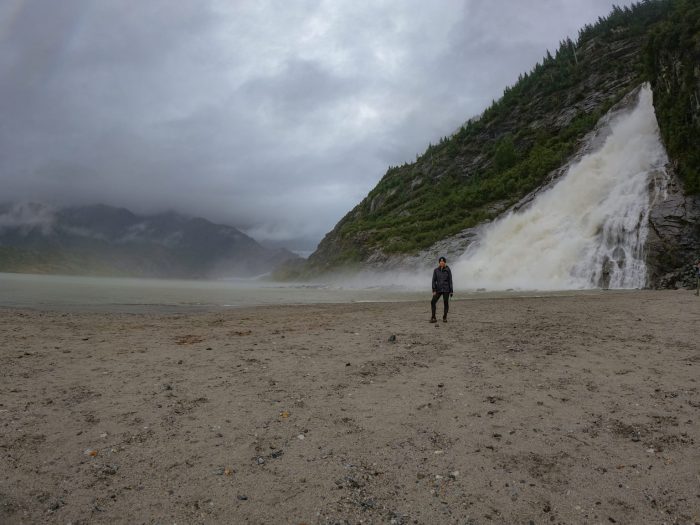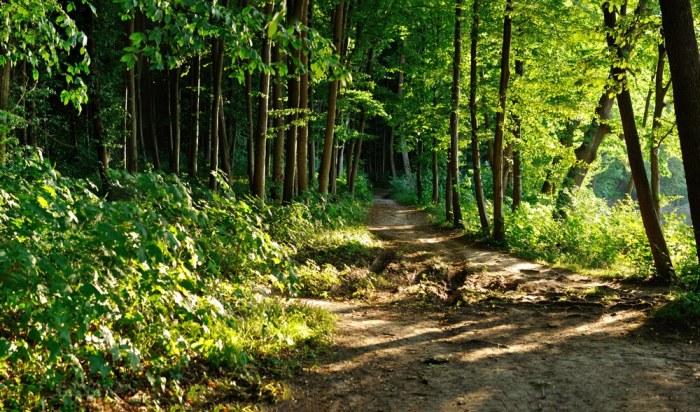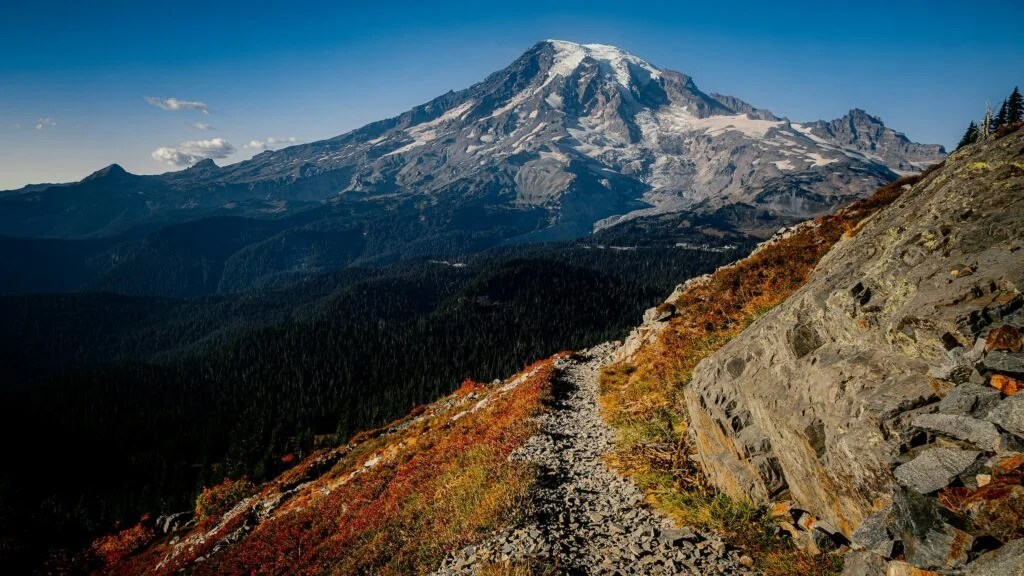Nature hikes near me sets the stage for an exciting exploration of local trails. Discover nearby destinations, from gentle strolls to challenging climbs, tailored to your preferred difficulty and time commitment. This guide provides a comprehensive resource for planning your next outdoor adventure.
We’ll delve into finding the perfect trail based on your location and desired experience, covering everything from easy riverside walks to demanding mountain ascents. Learn about the essential gear, safety precautions, and how to plan for any weather conditions. Visual representations of trails, including maps and elevation profiles, will make the search intuitive and engaging. Ultimately, this guide empowers you to embark on a memorable nature hike, right in your own backyard.
Defining the Search Area

Source: alicesadventuresonearth.com
Exploring nature hikes near you offers a rewarding way to connect with the outdoors. Understanding the fundamentals of hiking, like the techniques and considerations involved, is key to a safe and enjoyable experience. For a comprehensive overview of the definition of hiking, consult this valuable resource: Hiking Definition. Ultimately, planning your nature hikes near you can lead to fulfilling outdoor adventures.
Pinpointing nature hikes near you involves a multifaceted approach, leveraging location data and user preferences to deliver precise results. This process streamlines the search, ensuring users find trails perfectly aligned with their desired proximity and location.This crucial step allows users to focus on hikes within a specific radius, saving time and effort. Effective implementation of this feature is essential for a robust search engine, enabling a tailored experience for each user.
Distance Preferences
Users often seek hikes within a specific range of distances. Establishing clear distance preferences significantly narrows the search results.Defining distance parameters, such as within 10 miles, 25 miles, or 50 miles, refines the search area. This tailored approach allows users to explore hikes that fit their time constraints and mobility.
Incorporating User Location
Leveraging user location data refines the search significantly. This personalized approach provides results precisely tailored to the user’s current location.
User location data, if available, significantly enhances the search experience by delivering highly targeted results.
This feature is crucial for offering a streamlined and effective search process. The user’s location, whether automatically detected or manually entered, becomes the cornerstone for pinpointing suitable hikes.
Presenting Distance Options
Presenting distance options in a user-friendly format is key to a smooth user experience.A dropdown menu or a slider offers a seamless way to select the desired distance. The user interface should intuitively guide users through the process, making it easy to specify the radius of their search. This ensures a positive and efficient experience.
- A dropdown menu allows for quick selection of pre-defined distances, like 5 miles, 10 miles, 25 miles, or 50 miles.
- A slider provides a more dynamic approach, enabling users to adjust the distance range with precision.
Location-Based Inputs
Various inputs allow users to specify their desired location. These inputs are vital for pinpointing the search area and deliver highly relevant results.Precise location data is crucial for an effective search engine.
- City: (e.g., “San Francisco”)
- State: (e.g., “California”)
- Zip Code: (e.g., “94103”)
- Coordinates: (e.g., “37.7749° N, 122.4194° W”)
Hiking Trail Characteristics
Nature hikes offer a diverse range of experiences, catering to varying levels of fitness and preferences. Understanding the characteristics of different trails is crucial for planning a safe and enjoyable outing. From gentle strolls to strenuous ascents, hikers can choose a path that matches their abilities and aspirations.A well-structured approach to categorizing hikes considers difficulty, distance, elevation gain, and estimated time.
This allows for informed decisions and ensures a positive experience for all participants. This framework provides a clear picture of what to expect from each trail, facilitating a more mindful and strategic approach to choosing the right hike.
Exploring nature hikes near me is a rewarding way to connect with the outdoors. Finding the perfect trail, however, can be challenging. Fortunately, discovering easy hikes near me can be a great starting point. Check out this resource for top recommendations on easy hikes near me to help you narrow down your options. Ultimately, the goal is to discover fantastic nature hikes near me that cater to your preferred level of exertion.
Hike Types and Difficulty
Different hike types cater to various levels of physical preparedness. Easy hikes are suitable for beginners and families, while challenging hikes test the limits of seasoned hikers. The difficulty level is intrinsically linked to factors such as elevation gain, terrain, and trail maintenance.
Categorizing Hikes by Attributes
A structured approach to classifying hikes based on key attributes is essential for effective planning. This involves classifying hikes by difficulty, distance, elevation gain, and estimated time. This system ensures that hikers choose trails aligned with their abilities.
Difficulty, Distance, and Duration
The table below illustrates a common framework for categorizing hikes by difficulty, distance, and duration. This categorization helps users choose trails that align with their experience levels and time commitments.
Exploring nature hikes near you offers a refreshing escape. However, if time is limited, discovering short hikes near me, like those detailed in this helpful guide short hikes near me , can still provide a satisfying connection with nature. Ultimately, the best approach to finding the perfect nature hike near you depends on your personal preferences and available time.
| Hike Type | Difficulty | Distance (miles) | Duration (hours) |
|---|---|---|---|
| Easy | Beginner | 2-5 | 2-4 |
| Moderate | Intermediate | 5-10 | 4-6 |
| Challenging | Advanced | 10+ | 6+ |
Typical Nature Hike Features
A typical nature hike involves exploring natural landscapes, often with varying degrees of elevation changes. Natural scenery is a defining feature, with opportunities to encounter diverse flora and fauna. Wildlife sightings, depending on the location and season, can range from birds and small mammals to larger animals. The experience often includes a sense of tranquility and immersion in nature.
Nature Hike Destinations
Exploring nature offers a unique blend of physical activity and mental rejuvenation. Choosing the right destination enhances the experience, aligning with personal preferences and desired challenges. This section explores diverse natural landscapes, highlighting their unique attributes and suggesting destinations for various interests.The diverse natural environments present unique opportunities for hikers. From the tranquility of a forest floor to the breathtaking views from mountain peaks, each landscape offers distinct appeals.
Understanding these characteristics allows hikers to tailor their choices to their specific interests and abilities.
Forest Hikes
Forests provide a rich tapestry of sights and sounds. The dense canopy filters sunlight, creating a cool, shaded environment ideal for moderate hikes. Abundant wildlife sightings are possible, enriching the experience. The intricate network of trails allows for varied exploration depths. Examples include the trails within national forests like the Appalachian Trail or the vast coniferous forests of the Pacific Northwest.
The challenge level varies significantly, from gentle strolls through meadows to demanding climbs through dense undergrowth.
Mountain Hikes
Mountain hikes present a significant physical challenge, often rewarding hikers with panoramic vistas and a sense of accomplishment. The varied terrain, from rocky ascents to winding switchbacks, requires hikers to adapt their pace and technique. Altitude changes significantly affect the experience, influencing the difficulty and the scenery. Notable examples include the challenging peaks of the Alps or the iconic trails of the Rocky Mountains.
Hikers should carefully assess their fitness level and acclimatize to altitude changes before embarking on such expeditions.
Beach Hikes
Coastal hikes offer a unique blend of nature and the ocean’s influence. The proximity to the water creates a refreshing atmosphere, often accompanied by the rhythmic sound of waves. The terrain can vary from soft sand to rocky shores, adding to the diverse experience. Beach hikes provide opportunities to spot marine life, such as birds and sea creatures, and often offer stunning sunrises and sunsets.
Exploring nature trails near you offers a wealth of opportunities for rejuvenation and discovery. But if you’re looking for a more challenging yet rewarding experience, consider hiking mountains near me. Finding the perfect trail for a memorable adventure is crucial, and resources like hiking mountains near me can help you locate stunning mountain hikes. Ultimately, choosing a nature hike near you can provide a unique connection with the natural world, fostering a sense of well-being.
Examples include the coastal trails along the Pacific Coast Highway or the rugged shores of the Outer Banks. Considerations include potential for strong winds, varying tide levels, and coastal erosion.
Desert Hikes, Nature hikes near me
Desert hikes present a unique challenge, requiring hikers to adapt to extreme temperatures and arid conditions. The sparse vegetation and unique rock formations create a dramatic landscape. Hiking in deserts often requires careful water management and adherence to safety guidelines, particularly during peak heat periods. Examples include the Sonoran Desert trails or the Mojave Desert’s scenic routes.
Essential gear includes ample water, sunscreen, and appropriate protective clothing.
Hiking Destination List
| Destination | Description | Resources |
|---|---|---|
| Appalachian Trail | A long-distance hiking trail traversing the Appalachian Mountains. | https://www.appalachiantrail.org/ |
| Rocky Mountains | A mountain range with numerous trails for various difficulty levels. | https://www.nps.gov/romo/index.htm |
| Pacific Coast Highway | A scenic coastal drive with access to various hiking trails. | https://www.nps.gov/calo/index.htm |
| Sonoran Desert | A desert ecosystem with unique flora and fauna. | https://www.nps.gov/sagu/index.htm |
Hike Planning and Resources

Source: theteacenter.org
Pre-emptive planning is crucial for a successful and safe outdoor adventure. Thorough preparation mitigates risks and enhances the overall enjoyment of your nature hike. Considering the specific conditions of your chosen trail and location is essential for a positive experience.
Weather Considerations
Accurately predicting and understanding weather conditions is paramount. Unforeseen changes in weather patterns can dramatically impact a hike’s safety and enjoyment. Before embarking on any hike, it’s critical to check the weather forecast for the specific area and time of your intended hike. This includes reviewing temperature predictions, potential precipitation, wind speeds, and any possible extreme weather events.
Local weather reports provide a more precise understanding of the expected conditions, offering insights into possible variations from broader regional forecasts. For instance, a mountain summit might experience significantly different weather conditions compared to a valley floor, requiring tailored preparation.
Essential Gear and Equipment
Proper gear is vital for a comfortable and safe hike. This includes appropriate clothing, footwear, and essential supplies. Suitable clothing should consider the expected temperature range and potential for rain or sun exposure. Durable hiking boots provide ankle support and traction on various terrains. Essential supplies such as water, snacks, and first-aid provisions should be included in your backpack.
Navigation tools, such as a map and compass or a GPS device, are critical for maintaining a safe course and ensuring you can return to your starting point. A whistle can also signal for help in case of an emergency.
Safety Considerations
Potential safety hazards should be anticipated and mitigated before setting out. Trail closures due to maintenance, weather, or other unforeseen events should be verified. Awareness of potential wildlife encounters, such as bears or venomous snakes, is vital. Knowing the typical wildlife patterns and behaviors for your chosen area is key to minimizing risks. Carrying bear spray or other safety equipment, if necessary, is crucial for managing wildlife interactions.
Pre-Hike Checklist
Thorough preparation is a cornerstone of a safe and enjoyable hike. This includes meticulous consideration of several factors before setting out.
- Weather Verification: Confirm the weather forecast for the specific area and time of your hike. This includes checking temperature, precipitation, wind, and any potential severe weather warnings.
- Gear Assessment: Ensure that you have the appropriate clothing, footwear, and supplies for the hike. Consider the terrain, elevation, and expected conditions. Check the functionality of any essential equipment, such as navigation tools or first-aid supplies.
- Safety Protocol: Confirm trail conditions and potential closures. Be aware of potential wildlife encounters in the area and consider necessary safety precautions. Inform someone of your hiking plans, including your route, expected return time, and emergency contact information.
Visual Representation of Hikes
A crucial element for enhancing the user experience and facilitating informed decisions is the visual representation of hiking trails. Effective visualizations transform complex data into easily digestible information, empowering users to plan their excursions with confidence. This section details the key components for creating compelling visual representations, ranging from interactive maps to detailed elevation profiles.Clear and intuitive visualizations are essential for attracting and retaining users.
They allow for seamless exploration of trail characteristics, enabling hikers to make informed choices about their next adventure. The ability to visualize elevation changes, trail difficulty, and scenic highlights significantly enhances the user experience.
Interactive Maps and Route Planning Tools
Visualizing hiking trails through interactive maps and route planning tools empowers users to explore potential routes in detail. These tools should offer features like zooming, panning, and overlaying trail markers, making the exploration process more immersive. Users should be able to quickly identify trailheads, junctions, and key landmarks.An interactive map should allow users to explore different routes, analyze their respective lengths and difficulties, and gain an overview of the surrounding environment.
This includes showing points of interest, such as waterfalls, historical sites, or scenic overlooks. Advanced features could include route planning tools that consider user-defined preferences, such as elevation gain, distance, and estimated time.
Elevation Profiles
Visualizing elevation profiles provides critical information about a trail’s terrain. Graphically representing elevation changes allows users to assess the overall difficulty and anticipate potential exertion levels. A well-designed elevation profile displays the trail’s ascent and descent patterns, showing the steepness and length of climbs and descents.An effective elevation profile would display elevation changes in a clear and concise manner.
A line graph showing elevation against distance along the trail is ideal. Color-coding or shading can be used to highlight sections with significant elevation changes, providing a visual cue to the trail’s difficulty. The inclusion of key data points, such as the maximum elevation gain, average grade, and total elevation change, can provide further insight.
Trail Maps and Directions
Detailed trail maps are crucial for navigating a hike safely and efficiently. The maps should clearly depict the trail’s path, including junctions, trail markers, and points of interest. Clear and concise trail markers, such as waypoints or mile markers, aid in navigation. The trail map should be accompanied by precise directions and clear signage, allowing hikers to confidently follow the path.Visual representations of trail maps should incorporate clear markings for trailheads, junctions, and points of interest.
Trails should be clearly delineated with varying line thicknesses or colors to represent different trail types or difficulties. A legend or key explaining the symbols and colors used on the map should be prominently displayed. Comprehensive trail markers should be included, enabling users to follow the route easily.
Interactive Elements
Enhancing the user experience is paramount in a nature hiking platform. Interactive elements can significantly boost engagement, allowing users to personalize their search, share their experiences, and contribute to a vibrant community. This section details methods for creating an interactive and user-friendly platform.Providing a dynamic platform for nature enthusiasts demands interactive features. These features empower users, fostering a sense of community and facilitating personalized exploration.
Interactive Search Methods
A robust search engine is crucial for finding the perfect hike. Users should be able to filter hikes by difficulty, distance, duration, terrain, and amenities like water sources or restrooms. Advanced search options, such as specifying desired flora or fauna, or the presence of specific features, like scenic overlooks, will greatly enhance the search. Geolocation should be seamlessly integrated to display hikes near the user’s current location, or allow for input of a specific location.
Saving Favorite Hikes
Users need a simple and intuitive method to save hikes for later reference. This feature should allow users to tag hikes with descriptive names, adding details like ideal season, difficulty rating, or notes about specific trail conditions. Integration with a user account is recommended for persistent storage.
Sharing Hiking Experiences
Facilitating the sharing of hiking experiences is vital to building community. Users should be able to upload photos, videos, and detailed descriptions of their hikes. A rating system, incorporating reviews and comments, allows users to learn from others’ experiences. The platform should also facilitate the creation of groups or forums for users to connect and discuss hiking routes.
User Reviews and Ratings
User-generated content is invaluable for assessing hiking trails. A comprehensive review system should allow users to rate hikes on various factors, such as difficulty, scenery, and overall enjoyment. Integration of these ratings with a star system and written feedback will provide valuable information for other users, enhancing their hike planning process. These reviews should be clearly categorized and displayed to help users filter hikes based on the experiences of others.
A moderation process is essential to ensure the integrity of reviews.
Final Thoughts: Nature Hikes Near Me

Source: backpacker.com
In conclusion, discovering nature hikes near you is easier than ever with this comprehensive guide. From pinpointing the ideal trail based on distance and difficulty to understanding crucial safety measures, we’ve covered all the bases. The interactive elements ensure a personalized experience, allowing you to save your favorites, share your adventures, and benefit from community insights. So, get ready to explore the natural beauty around you – your next adventure awaits!
FAQ Resource
How far from my location should I search for hikes?
The search area can be customized by distance preference, such as within 10, 25, or 50 miles from your current location. You can also enter a city, state, zip code, or coordinates.
What types of nature hikes are available?
Hikes are categorized by difficulty – easy, moderate, or challenging – and by characteristics like distance, elevation gain, and estimated time. A table Artikels these different categories.
What safety precautions should I take before a hike?
Always check weather conditions, pack appropriate gear, and be aware of potential trail closures and wildlife encounters. Consider safety in your planning process.






Leave a Reply